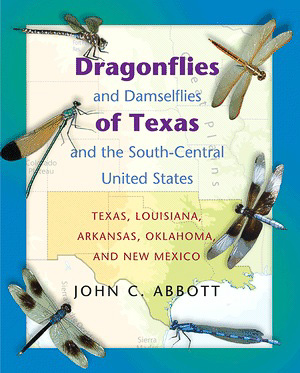by John C. Abbott
Published by Princeton
 |
From the publisher: This is the first guide to dragonflies and damselflies of the south-central United States. The book covers 263 species, representing more than half of the North American fauna. The area of coverage significantly overlaps with other regions of the country making this book a useful aid in identifying the dragonflies and damselflies in any part of the United States, Canada, or northeastern Mexico. More photographs of damselflies in North America appear here than in any other previously published work. All 85 damselfly and 178 dragonfly species found in the region are distinguished by photographs, numerous line drawings, keys, and detailed descriptions to help with identifications.
This is a complete and authoritative guide to the Odonata of Texas, Louisiana, Arkansas, Oklahoma and New Mexico. It is not really a field guide in the modern sense - it is a rather bulky paperback, organised in the old-fashioned way, with detailed species descriptions and a separate section of plates in the middle of the book. Nevertheless, it contains everything needed for identification of the species, and more besides.
The short introduction contains the usual summary of the life-history, study and conservation of dragonflies and damselflies, without which any guide would seem incomplete, but also a useful discussion of the habitats and zoogeography of the southern United States and a detailed, illustrated section on the external anatomy of the insects, essential for the detailed descriptions that follow. From the outset you feel this is a book written by a scientist, who really knows his subject.
At the end of the introduction is a dichotomous key to the families and further keys throughout the text narrow down the identification to species level. This is obviously most useful if you have a specimen in your hand, especially as the features referenced are frequently anatomical. Nevertheless, they are external features, most or all of which would be revealed by good photographs taken in the hand or if you are lucky, the field, and I consider this a strong point. The serious naturalist needs this kind of systematic approach to be sure of identifying difficult groups. The species descriptions themselves are very complete and accompanied by detailed text diagrams and comparative tables. Points of distinction from similar species are indicated after each description. There is also a detailed distribution map, information on flight period and habitat and a 'discussion' - brief or substantial depending on how much additional comment the author feels is pertinent to the species.
The photos are good and include typically two, sometimes three images of each species. Because they are collected together in the middle you can skim through them looking for something similar your dragonfly, a bit like thumbing through a field guide. Unfortunately, however, no page numbers are given in the plates to help the reader locate the relevant text. If you think, 'Ah yes, this is a pronghorn clubtail!' you then have to look up 'pronghorn clubtail' in the index or thumb through the pages until you find it. This is a silly and slightly annoying fault, which makes the book less accessible to beginners - clearly, the author sees the plates as a supplementary, rather than primary resource. For that reason, a neophyte visiting the southern states might find it easier to use the Princeton Field Guides (see review of these), which gather everything together in one place. For the serious naturalist, however, this present book would seem to be the definitive guide to the region and I give it my strong recommendation!
The book can be purchased from Princeton University Press.